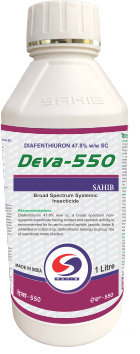
SAHIB DEVA-550
Sahib Deva, a broad spectrum non-systemic insecticide having contact and stomach activity is recommended for its use to control Aphids, Jassids, Thrips & Whiteflies in the Cotton crops. Diafenthiuron belongs to group 12A of insecticide mode of action.
- Availability In Stock
- Shipping 01 day shipping. Free pickup today
- Weight 0.5 kg
- Share on
AI (gm)Crop(s) Common Name of Pest Dosage/HA Dilution in Waterin water (liter) Waiting Period between last spray to harvestdays Re-entry after each Applicatio n (In Hours) Formulation (ml) Cotton Aphids, Jassids Thrips & Whiteflies 239 500 500 30 -
Shake the container before use. Measure out the required quantity of the product and mix it well with a small quantity of water. Add the remaining quantity of water as specified with thorough agitation for total coverage of the crop with a suitable sprayer. Apply the insecticide when the incidence of sucking pests is first observed and repeat applications as necessary. Apply the insecticide with a knapsack sprayer or any other relevant sprayer in a sufficient quantity of water to ensure thorough coverage of the foliage. Insect Resistance Management (IRM) In order to avoid resistance development it is strongly recommended to use Diafenthiuron 47.8% w/w SC in rotation with other recommended products with a different mode of action, in line with insecticide Resistance Management principles. Use as per the label and avoid using less than the labeled dose. Time of Application Apply the first spray as soon as pest infestation reaches Economic Threshold Level (ETL) and subsequently give 1-2 sprays at the interval of 10- 15 days depending upon pest infestation.
Do not use cooking utensils for preparing sprays. Use a stick for stirring the spray solution. Wear hand gloves to avoid contact with the skin. Also, avoid inhalation and contact with the eyes. Wear protective clothing, goggles, and boots, etc. while spraying, and do not expose yourself to spray drift. Do not blow nozzles with your mouth. Do not eat, drink or smoke while handling or applying the product. Do not store unused spray solution. Clean sprayers, buckets, and other utensils with water daily after use. Wash hands with soap and plenty of water and change clothes after the work is over. Also, wash the contaminated clothes. Do not contaminate streams, ponds waterways, etc by discharging leftover spray materials or by cleaning sprayers, contaminated buckets, etc. into them. The spilled products must not be reused. In case of any sign of poisoning, immediately consult the doctor. The product is toxic to fish, crustaceans, and other aquatic organisms. The product should not be used in areas where pisciculture is practiced. Avoid direct contamination of surface water and contamination caused by spray drift. Do not contaminate soil, or stagnant or running water by disposal of waste. Toxic to honey bees. Do not spray during the active bee-foraging period of the day. As the product may be toxic to honey bees.
Poisoning may cause symptoms of subdued behavior, prostration, lethargy, piloerection, headache giddiness, vertigo, nausea, vomiting blurred vision, sweating, excessive lacrimation & salivation.
1. The packages containing the insecticides should be stored in original containers in separate rooms or premises away from the rooms or premises used for storing other articles of food or shall be kept in separate almirahs under lock and key.
2. The rooms or premises meant for storing the insecticide shall be well-built, dry, well-lit, and ventilated and of sufficient dimensions to avoid contamination with vapor. 3. Keep away from direct sunlight. 4. Store away from children unauthorized persons and animals.
No specific antidote is known. apply symptomatic therapy.